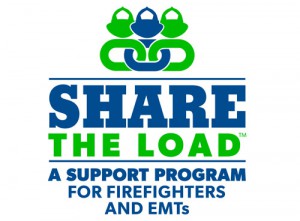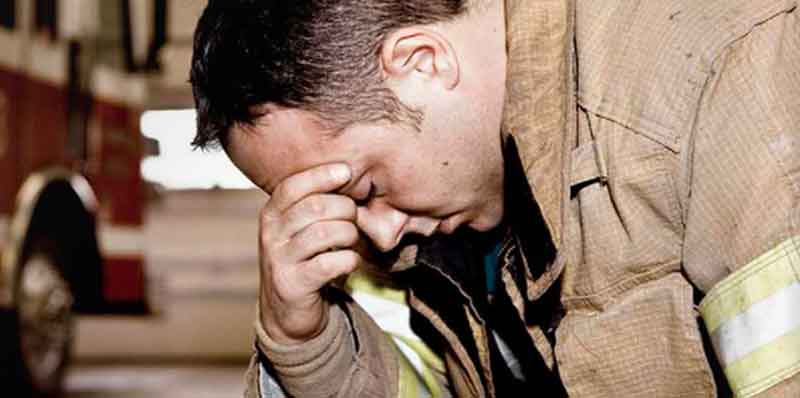
By the U.S. Fire Administration (USFA)
Are firefighters who show symptoms of burnout less likely to follow safety procedures?
A team of researchers recently set out to learn if burnout impacted a firefighter’s ability to follow required safe work practices, care for and safely use personal protective equipment (PPE), and communicate and report safety concerns.1
The team also wanted to assess the direct effects that work stress and work-family conflict have on burnout.
This study was funded by a Fire Prevention and Safety grant (Research and Development) under the Assistance to Firefighters Grant Program.
As a firefighter, you work in physically, emotionally and psychologically challenging situations — sometimes with limited resources.
You also face the added pressure of performing safely and effectively under significant time constraints.
These difficult work conditions can lead to burnout over the long-term.
Burnout is generally defined as a psychological response to chronic work stress and is recognized as having three major components:
- Exhaustion.
- Disengagement or withdrawal from the workplace and co-workers.
- Cynicism or unsympathetic attitude towards the people and goals they serve.
Along with improvements in things such as turnout gear, equipment, improved medical care and screenings, etc., there is still a need to address other factors, which would include psychosocial and organizational factors that haven’t been researched and addressed extensively within the fire service.
— Study authors
(The National Volunteer Fire Council’s (NVFC) Share the Load support program helps firefighters, EMTs, and their families address a variety of behavioral health issues, including PTSD, depression, suicide risk, substance abuse, and anxiety. This video helps first responders and family members recognize the symptoms of five common behavioral health issues and where they can turn to for help. Courtesy of the National Volunteer Fire Council and YouTube. Posted on Dec 15, 2014.)
What did the research team learn?
Findings
Study results clearly showed that burnout leads to diminished safety behaviors in firefighters. It should be considered a legitimate safety concern within the fire service.
Work stress and work-family conflict are not directly linked to bad safety practices. They can, however, lead to burnout over time, which is the major predictor of unsafe work practices.
When firefighters are burned out, they are less likely to voice their safety concerns, to use PPE properly, and to perform their work in a routinely safe manner.
Suggested safety interventions
The research team had these recommendations for fire department leaders to prevent burnout and promote safe behaviors:
-
Place an emphasis on a safety-conscious transformational style of leadership.
- This will counter many of the stressors that lead to burnout.
- This style of leadership also promotes fairness and equity and it builds engagement.
-
Require supervisors to provide rest and rehabilitation during firefighting operations, and allow for post-event rest and recovery.
-
Promote health and wellness goals and a positive safety climate.
- This will help to counter the effects of stressors that may lead to burnout.
Learn more about this research
This research article is available through USFA library by contacting netclrc@fema.dhs.gov.
1Smith, T D., Hughes, K., DeJoy, D., Dyal, M. (2018). Assessment of relationships between work stress, work-family conflict, burnout and firefighter safety behavior outcomes. Safety Science: Vol 103 (March 2018). doi:10.1016/j.ssci.2017.12.005
Original post https://www.usfa.fema.gov/current_events/072618.html

Share the Load™ Support Program for Fire and EMS
Most people are aware of the physical demands that first response activities place on firefighters and EMS providers.
But it is important to also realize the impact that fighting fires and responding to emergencies has on the mental wellbeing of emergency personnel.
Firefighters and EMS providers face the risk of many behavioral health concerns such as anxiety, depression, burnout, post-traumatic stress disorder, and addiction among others.
Taking care of your mental health is as important as managing your physical health.

The NVFC’s Share the Load™ program provides access to critical resources and information to help first responders and their families manage and overcome personal and work-related problems.
This includes the Fire/EMS Helpline, which offers free 24-hour assistance with issues such as stress, depression, addiction, PTSD, and more.
The resources in this section can assist individuals seeking help for a behavioral health issue as well as departments looking to implement or enhance a behavioral health program.
- Fire/EMS Helpline – 1-888-731-FIRE (3473)
- Share the Load™ Resources (Helpletter, poster, ads, family guide, suicide prevention report, training)
- Share the Load Videos featuring warning signs to watch for, personal stories, how to talk to someone who needs help, and resources that are available.
- Additional Fire Service and EMS Behavioral Health Resources (organizations, helplines, reports, courses and webinars).
- Articles and news on behavioral health topics.
(Courtesy and with Grateful Thanks to BlueLine Patriot and YouTube. If you or someone you know is in need of help, remember that you are not weak. You are experiencing things a normal person would never understand or be able to comprehend. Please talk to someone, you are worth more than you can possibly imagine. https://suicidepreventionlifeline.org/ tel: 1-800-273-8255. Posted on Jun 3, 2017)
National Fire Service Suicide Reporting System
We tragically lose dozens of firefighters and EMTs each year to suicide.
The Firefighter Behavioral Health Alliance is the nationally recognized reporting system for collecting data about firefighter suicide.
The reporting system is confidential and the data is used to identify trends and prevent future instances of firefighter and EMT suicide.
To report a suicide, go to www.ffbha.org and click on “FF Suicide Report” in the left menu.
Learn More about the NVFC Share the Load program at www.nvfc.org/help.
Learn More…
Diary of a Suicidal Cop: ‘Inside it’s a War’ (Important: Please Read & Share)
New Turnout Gear Aims to Reduce Firefighter Cancer Risk (Multi-Video)
















